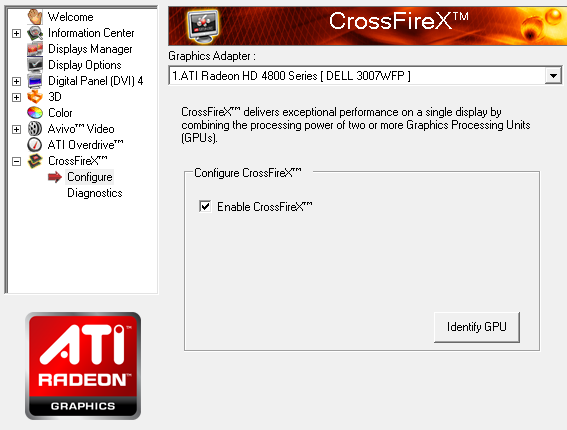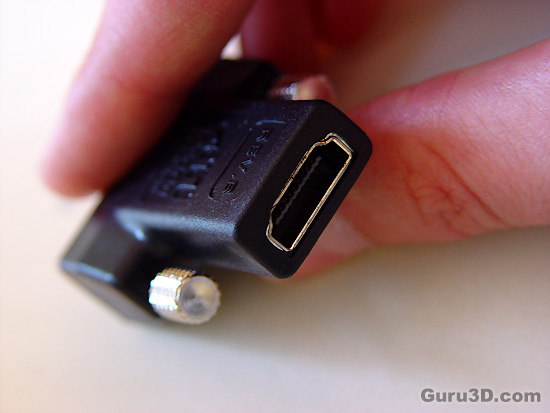4 - UVD 2.0
ATI CrossfireX
With selected mainboards (pretty much anything not NVIDIA) you can combine one, two, three or even four graphics cards together in Crossfire mode. That's a lot of future redundancy. In today's article we'll have to forfeit on this feature, as well .. I do not have enough 4870 boards right now. next week, I promise, we'll do another article on that. And yes, we'll also try mixing and matching other model Radeon cards.
DirectX 10.1
Both the Radeon HD 4850 & 4870 have support for the DirectX 10.1 API, introducing a new layer of extensions. DirectX 10.1 was launched with the Windows Vista Service Pack 1 and is backwards compatible with the existing DirectX 10 layer. Make no mistake, DX10.1 fully supports DX10 hardware. And DX10.0 class cards will still play DX10.1 games just fine.
It's basically an update to DX10 that extends the hardware functionality slightly. All the hardware is still supported, all the games still run, all the features are still there, it's just simply extended the feature set and the lifetime of the API. The release mainly sets a few more image quality standards for graphics vendors, while giving developers more control over image quality. Features scheduled for DirectX 10.1 include:
- Mandatory 32-bit floating point filtering
- Mandatory 4x anti-aliasing
- Shader model 4.1
 For DX 10.1 gaming you'll likely need two or more cards ... (duh).
For DX 10.1 gaming you'll likely need two or more cards ... (duh).
UVD 2.0
UVD provides hardware acceleration of H.264 and VC-1 high definition video formats used by Blu-ray and HD DVD. The video processor allows the GPU to apply hardware acceleration and video processing functions while keeping power consumption & CPU utilization low. When the HD 2900 XT was released it took the press by surprise that the low-cost HD 2400 and 2600 where able to post-processes and accelerate HD streams like VC1 and H.264 fine while the 400 USD counterpart missed that engine and thus that translated into much higher CPU utilization.
Sheer decoding perfection you will have on both the HD 4850 and 4870. Low CPU utilization whilst scoring maximum image quality. One improvement has been made as well you can now upscale your 1920x1080 streams fine towards for example a 2560x1600 sized monitor (no more black borders).
New in the GPU architecture of the series 4000 is an update video engine. It's not much different opposed to the old UVD engine, yet has two new additions for post-processing, decoding and enhancing video streams. Dual stream decoding is one of the new features. for example if you playback a Blu-ray movie and simultaneous want to see a director's commentary (guided by video) you can now look at both the movie and (see it like picture in -picture) in a smaller screen see the additional content. Obviously this is blu-ray 2.0 compatibility here, and the additional content is an actual feature of the movie. But definitely fun to see.
A new feature also is dynamic contrast enhancement which was introduced by team green last year.
It does pretty much what the name says; dynamic contrast enhancement technology will improve the contrast ratios in videos in real-time on the fly. It's a bit of a trivial thing to do, as there are certain situations where you do not want your contrast increased. Think for example a scary thriller, dark environment ... and all of the sudden your trees light up. So with that in mind; the implementation has been done very delicately. It does work pretty well, but personally I'd rather tweak the contrast ratio myself and leave it at that. Another feature is Dynamic Color Enhancement. It's pretty much a color tone enhancement feature and will slightly enforce a color correction where it's needed. We'll show you that in a bit as I quite like this feature; it makes certain aspects of a movie a little more vivid.
Some like, others hate these features. I say it's good to have choices and anything that can enhance image quality is nice to have in my book. Directly tied to the UVD engine is obviously also sound. AMD's Radeon series 3000 and now 4000 cards have a feature that the competition does not have. It can pass lossless sound directly though the HDMI connector. This has been upgraded as it's now possible to have 7.1 channel lossless sound, meaning DTS-ES and all other formats now have become a reality. A very nice move indeed as that distance between the living room and your PC is getting smaller each year. Yours truly for example has a nice Onkyo receiver where I connect HDMI to. This receiver will take that 7.1 channel sounds with a lot of interest, process it, and then passes through the HDMI content itself to the HD television. All that over just one HDMI cable. Excellent stuff.
So with the Series 2000/3000/4000 you'll receive a DVI-to HDMI adapter which, and make no mistake here, will carry that sound over HDMI. That's unlike current DVI-HDMI adapters and cables which do not carry sound. Fantastic if you are watching a Blu-ray movie, simply connect HDMI towards your HDTV for PCM sound, or connect it through a TrueHD/Dolby HD receiver and get that sound lovin' going on through that receiver of yours. All with one simple cable.

Here we can see that DVI to HDMI dongle that is supported with the HD 2000/3000/4000 series Radeon graphics cards. I have to note that some board partners are now slowly making to move to integrate a HDMI connector on the graphics card.
